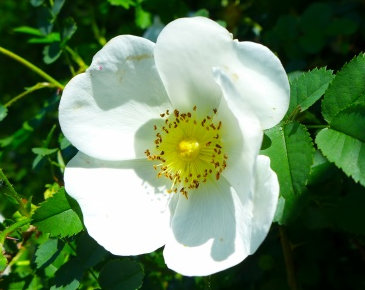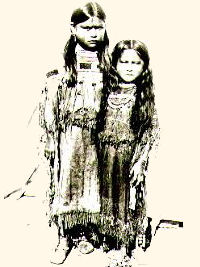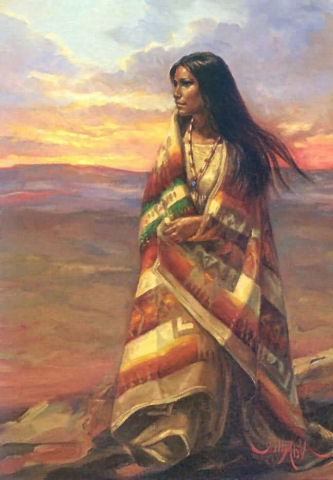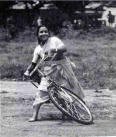
Neakita is my mother's name. It is the Choctaw Indian word for a type of wild rose. The flower the
Choctaw word refers to has a simple blossom with five white petals and a gold center. The Neakita
flower has a great and sad significance for the Choctaw. Legend says that anywhere a mother's tear
falls to the ground a wild rose will grow. These blossoms are plentiful in the thousand mile region
stretching from the deep south to Oklahoma. In the 1830's the route from Mississippi to Oklahoma came
to be known as "Nunna Daul Tsuny," which is Cherokee for The Trail of Tears.
My mother identified strongly with her Indian heritage. But like the American Indian in general, her life represents a
radical departure from that of her great grandmother. It is this woman, my great great grandmother, whose story I need to tell,
just as it was told to my mother.
She was born in 1830, a watershed year for her people. It was the year an infamous treaty
was signed at Dancing Rabbit Creek, in Mississippi. The treaty preamble says, "...the president of
the United States cannot protect the Choctaw people from the operation of these laws." The laws
referred to were some state legislation allowing Mississippi to take away the Choctaw land, 10.3 million
acres of lush farms and forest. The president referred to in the treaty is Andrew Jackson, who rose to
fame in a war against the Choctaw's brother nation, the Creek. The treaty was signed by each of the
Indian chiefs with an "X" which was followed by the interpreter's translation of their names,
Walking Wolf, Little Leader, Living War Club, and Big Axe.

Many of my relatives have interesting names, for instance; "Hogeye," "JD," and a pair of twins named
"Blackman and Whiteman." The Choctaw sometimes change their names following major changes in their lives,
but naturally the U.S. Government prefers that its citizens each have one legal name. So when it came
time to register the names of the natives in 1895, my great great grandmother, who had been named "Em"
at birth, legally became "Black Granny." Strangely enough, Em's daughter, my great
grandmother, also came to be named Black Granny. My siblings and I refer to them as Black Granny I and
Black Granny II.
As a toddler on the family farm, Em spent most days outdoors playing with dolls in the warm bright sunlight.
Traditional Choctaw religion is such that many refer to them as worshippers of sunlight.
The sun, who is called the Hush Tali, made the first people out of clay and placed them inside of a large mound of earth to bake.
When they were ready, he then laid them on the top of the mound to dry in the warmth of his light. The Hush Tali
is the first father, and the mound of earth, Nanih Wiya, is the first mother.
Neakita once told me how one day, as Em was playing, the edge of the Sun suddenly began to darken. Em's mother came running outside
clanging a pot with a large spoon and shouting "Funi lusa hushi umpa!" which means "Black Squirrel is eating the sun!"
The rest of Em's family, as well as the neighbors, began raising a huge ruckus by drumming anything available and shouting at the sky.

The tale of noisy commotion brought about by a solar eclipse is reportedly rooted in Choctaw folklore,
where Black Squirrel often wreaks havoc with the cosmos. In this case he had chosen to chew on the Hush Tali,
as though the sacred father of all mankind was no more than a tasty glowing hazelnut. A continuous chorus
of yelping, whooping, and banging was eventually sufficient to distract the mischievous critter from his
vandalism. The farm, the town, the Earth, all safe once again.
"Funi-lusa-osh mahlatah!" Black Squirrel is frightened.
Em was just five years old when her father's farm was sold to a white land baron by the state of
Mississippi. Her family received no compensation for the sale. All Em knew was that soldiers
came one winter and herded them up. Then they were forced to walk about a thousand miles. Some
fled into the swamps. Thousands of the elderly and children died from fatigue and exposure to the
cold. Many were barefoot. Shoes had been promised by the United States but never arrived.
The living carried the dead, thus increasing the burden, until the next resting stop where they were
hurriedly buried.
The survivors of the trek found themselves left in a wasteland that was a small fraction of the value
of their homeland. Borrowing a British quote about the Irish, it was said "There wasn't enough land to
feed them, not enough water for them to drink, and not enough trees to hang them all."
The Choctaw have never been at war with the United States. They are one of the so-called "civilized tribes."
By this it is meant that they have several characteristics that separate them from certain other Indian
tribes of North America. For instance they lived non-nomadic, staying in one general location for thousands
of years. They had cities with smaller surrounding villages subordinate to the cities. They were primarily
farmers, cultivating corn, beans, squash, sunflowers, and strawberries. They had representational government
and an intricate system of trade. So when the U.S. began the process of legitimizing the theft of
their land, they hired lawyers. Choctaw, Cherokee, and other tribes fought their cases all the way to the Supreme
Court. In a landmark case, Worcester v. Georgia, Chief Justice John Marshall declared the Indians equal
citizens under the constitution. President Jackson conspired with the states to ignore the decision,
remarking, "The decision of the Supreme Court has fell still-born."

When young Em arrived in the Red River Valley of southeast Oklahoma, she lived the next year of
her life in an "overjet." This was a small cabin built on the back of a wagon, a sort of precursor
to the motor home. The cabin hung over the sides of the wagon bed, thus the name. During that
first year the Choctaw set aside a central area for three essential community services. First,
they built a cemetery. It is a big field of tall weeds and a few oak trees. Large smooth stones
carried up from the creek mark the graves. Second, they built a school where children attended
until their early teens, at which time they could begin working in the fields. The third construction
was the Stomping Grounds. This was where the traditional Choctaw dancing was done. Em danced to the
drumming, with strands of jingling tortoise shells tied around her ankles. She loved to dance.
She was still a dancer long after she assumed the name of Black Granny.
Black Granny spoke Muskogean, the language of the Choctaw. It can be described as musical, punctuated by breathy breaks.
Oklahoma is their word for "red people." Bayou is another Choctaw word, meaning "swamp." Black Granny could not read or write.
She lived most of her life without a single document. The government issued her a birth certificate when she was 65.

In her prime Black Granny was a beautiful woman with piercing black eyes and skin the color of
copper. She was a medicine woman, which to the Choctaw means a healer, and to the whites means a
witch. Whenever her duties allowed, she would go fishing. Another favorite past time was to
hide in the weeds of the graveyard and make eerie howls to frighten children as they passed by.
She had seven children by seven different husbands. The Choctaw wedding involves the groom
presenting the bride with a blanket. If the woman ever wants a divorce she simply cuts the
blanket in two, sending the husband on his way with his half.
When my mother was 7 years old her parents received a letter edged in black. Black Granny
had died at the age of 104.
Black Granny II received her birth certificate the same year as her mother, Black Granny I. But unlike her mother,
she could read and write. When the government conducted their census of the Indians in 1890 she wrote on the form that she was white,
even though she was full blood Choctaw. Many did the same out of fear. Some of the tribe wrote that they were black.
Some wrote that they were 1/64th Choctaw, just enough to claim heritage but be considered as mostly white.
The reasoning behind this "little white lie" is clear. The United States had come and taken a count of the tribe
members before, just before the Trail of Tears.
Black Granny II was known for waking up angry, at least until she had her morning coffee and
snuff. She loved drinking coffee and dipping snuff. She married Charlie, the grandson of Levi, a chief
who had signed the Treaty of Dancing Rabbit Creek. One day she tore the blanket and married
a half Choctaw / half European, my great grandfather. Then one day she ran away and lived the rest
of her life with Hogeye. Meanwhile my grandmother, Willa, was raised by her father, and married Joseph Meek.
This brings us back to Neakita. My mother was born in 1927. She grew up in
Scipio, Oklahoma, a town of about 50 people where she attended a one-room schoolhouse, and made it to the
third grade. There were 15 students in the school. My father attended there also and made it all the way to eighth. The children played tag, blind
man's bluff, red rover, and kick the can. They studied reading, with McGuffey's Readers. They
studied writing on little slates with chalk. They also studied geography, arithmetic, and history.
I have been to Scipio as a child and I could feel the history. There is a calmness there. I've seen the little
schoolhouse. I met Cecil, owner of the only store, which at that time was also the post office, the gas station,
and town hall. I walked the full length of the town and saw the fields of corn. It's a simple,
slow-paced, community. There were children climbing trees and old men playing dominoes. I even
met Black Granny II before she died at the age of 94.
I also recall as a child when, in anticipation of a solar eclipse, I prepared a special device to view the sun safely.
As the event began, I projected the solar image into a box through
a tiny pinhole pierced in foil. Suddenly my mother came running out of the house while loudly
banging a pot with a serving spoon. To the amazment of the neighbors, my siblings and I had soon
joined in the defense of the Hush Tali.
"Black Squirrel! Black Squirrel!"

Neakita died with grace and courage of cancer at age 73. My sister dressed her in a beautiful lavender robe
complete with beadwork and braids. She had carried our family into the
new millennium, and she brought with her the dignity she had learned as a child in Oklahoma.
There is a special place in southeast Oklahoma, right where the Trail of Tears ends. When Neakita
was a little girl her family would travel there along with others of her clan. They would camp for a
week or so, living in wagons, playing, laughing, and fishing. And dancing in the sunlight. It's a place called
Choctaw Creek, where thousands of white roses grow wild.